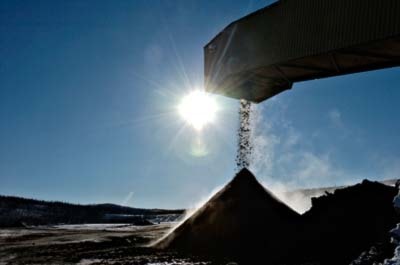The territory’s royalty regime is outdated and could suck profits from successful resource operations, says a Yukon advisory board stacked with mining executives.
The Quartz Mining Act must be overhauled to make the territory’s royalty regime better for mining companies, says the Yukon Minerals Advisory Board.
Its annual report for 2006 and 2007, which makes recommendations to increase the attractiveness of the Yukon to the mining industry, was tabled in the legislature earlier this month.
The Yukon Environmental and Socio-economic Assessment Board is unnecessarily adding another regulatory process, it said.
Repeated requests for more information from YESAB officers indicate “a lack of knowledge” on their part, not thoroughness, said the board in its 38-page report.
Other legislation needs reform to facilitate debt financing for mine development, said the board.
These are predictable conclusions of a 10-member board filled with nine people from some of the top mining companies operating in the Yukon.
Sherwood Copper Corporation president Stephen Quinn chairs the board.
The company runs the first hardrock mine to operate in the Yukon in the last decade.
Western Copper Corporation, which is involved in the first-ever YESAB executive committee assessment for its Carmacks mine, is a member.
So is Yukon Zinc Corporation, Alexco Resource Corporation, Copper Ridge Explorations and Access Consulting Group.
Chief of the Selkirk First Nation Darin Isaac sits on the board because of his experience working with the Minto mine, which operates on Category ‘A’ settlement land.
Six of 10 government-appointed board members are based in Vancouver.
The board is mandated to recommend policy to the government to increase mining activity in the Yukon, improve viability of mines and “reduce constraints, including government constraints, on the development of minerals in the Yukon.”
The board, which some call a government-sponsored lobby group, is perhaps one of the most influential in government.
“The mining industry is a very potent political power in the territory,” said Yukon Conservation Society mining co-ordinator Gerry Couture.
“When (the board) publishes a report, politicians take it seriously.”
In 2007, mining companies spent $130 million on mineral exploration, up 62 per cent from 2006 and up from roughly $30 million in 2005.
Total cost for the Minto Mine to date has been about $108 million, according to the board.
Mining in the territory is stronger now than it has been in a decade or so.
Over a decade of operation, the board has steered government policy towards a friendly atmosphere for mining companies, said Greg Komaromi, assistant deputy minister for oil, gas and minerals.
“Recommendations from the board are taken very seriously,” said Komaromi.
“We try and act on recommendations when it’s feasible for us to do so.”
The board is not simply a government-sponsored lobby group, but just another board fulfilling its mandate, he added.
When it meets, members are paid $125 per day and $62.50 in travel per day to a maximum of 12 days per year, according to a 1999 Order in Council document.
The chair makes $200 per day for meetings and $100 per day in travel to a maximum of 16 days per year.
If claiming the full amount, the 10-member board could cost the government $25,050 per year.
The board calls the Quartz Mining Act antiquated and asserts it needs to be reformed to ensure the Yukon is competitive with other Canadian jurisdictions.
The government should expedite its current review of legislation to take advantage of the hot mining industry, said the report.
The royalty regime has no cap and could result in a mine paying 100 per cent of its profits in taxes and royalties, said the board document.
The Yukon is and isn’t competitive with other jurisdictions, said Komaromi.
“The (royalties regime) works for smaller-sized mines,” he said. “The problem is, it isn’t capped.”
For larger operations, the royalties ladder — which increases the percentage of royalties as profits rise without limit — is untenable and could discourage large projects comparable to diamond mines in the Northwest Territories, said Komaromi.
The Yukon is already one of the most attractive places for mining companies, said Couture.
He cited a Fraser Institute study that ranked the territory as third best in Canada for the mining industry to do business.
Rather than calculating royalty payments based on profits, the government should be looking at a net smelter-based regime, said Couture.
“We should change (the calculations) to the value of what came out of the ground and sale price, not on whether the mining executives are good managers,” he said.
Mining companies make deals based on the value of minerals, not profits, so “should we be any less business-like?” said Couture.
In response to criticisms of the assessment process, YESAB executive board member Stephen Mills said the process is an evolving one and they’re always looking for ways to improve.
“It’s their opinion and their report,” said Mills.
“We’re not a regulatory body, but we inform the regulatory process.
“We have qualified people in all offices with wide-ranging experience.”
